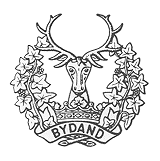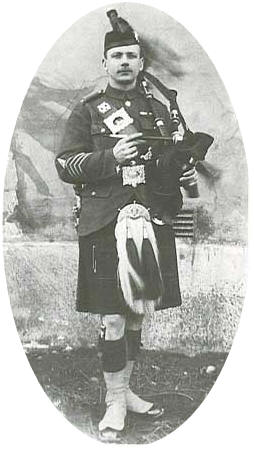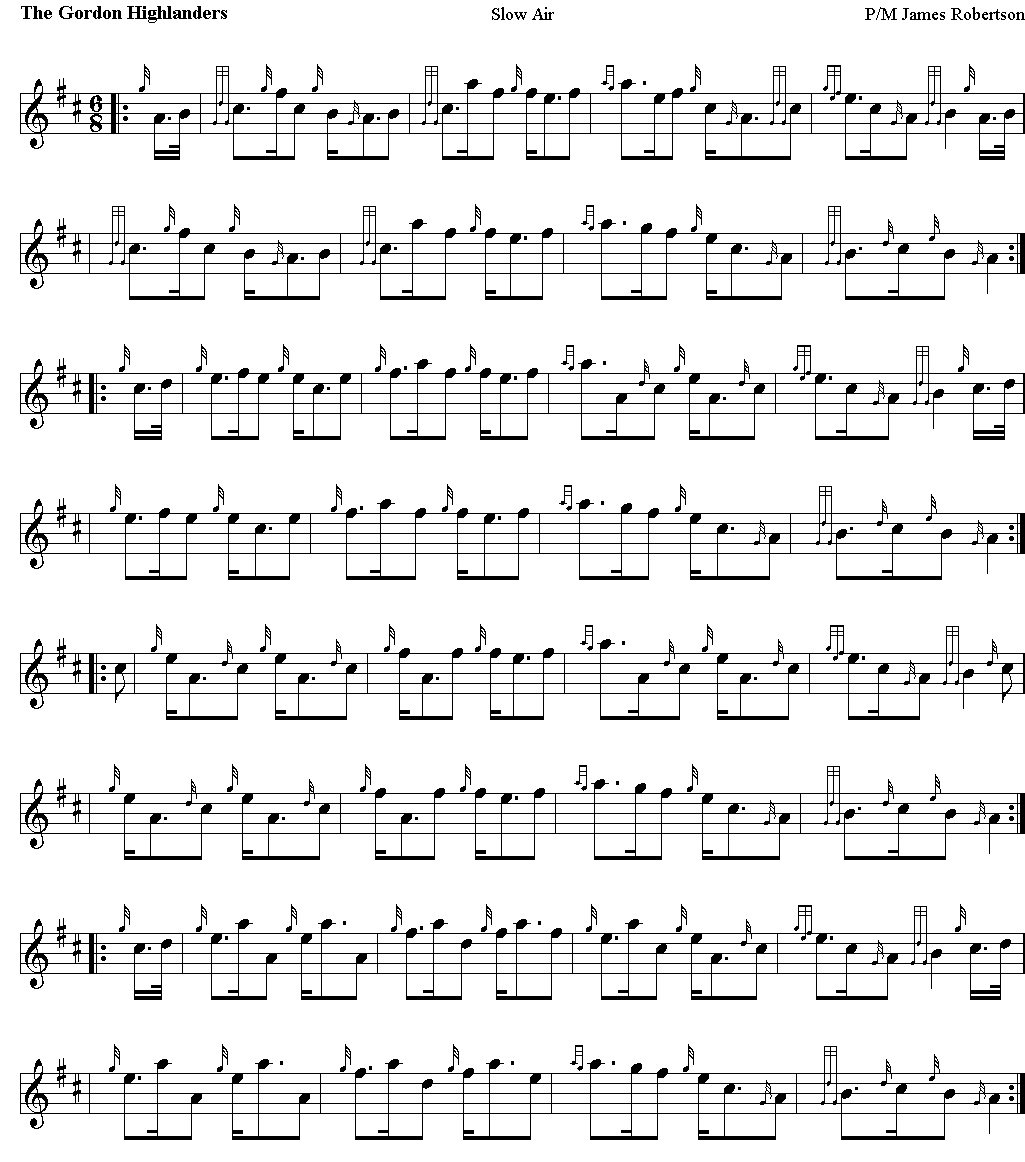 |
||

Best viewed in
|
In 1787 the 75th Regiment, the forerunner of the 1st battalion The Gordon Highlanders, was raised for service in the Far east, but it was not until 1793 when the French Revolutionary Government had declared war on Great Britain that the Government asked the Duke of Gordon to raise another regiment. The Duke having agreed, he received the authority on the 10th February, 1794, and the command was given to his son, the Marquess of Huntly, at that time a Lieutenant-Colonel in the 3rd, now the Scots Guards. The Duke himself, and his son, took a personal interest in the recruiting and the celebrated Duchess Jean, still a beautiful woman, lent to it all the prestige of her high position and the grace and charm of manner for which she was famed. She rode to the country fairs in Highland bonnet and regimental jacket and it is told how she gave a kiss to the men she enlisted. Sometimes she is said to have placed a guinea between her lips. On the 24th June, 1794 the newly embodied regiment was paraded for the first time at Aberdeen when they wore the then almost new, and now famous, tartan which had been devised by Forsythe of Huntly. Forsythe had taken the standard plaid and woven in a yellow stripe, which, as he wrote to Lord Huntly, he trusted would appear "very lively." It was at Gibraltar that the regiment, at that time not yet the 92nd, but the 100th Regiment of Foot, received their first colors and soon afterwards they were in Ireland making the acquaintance of Major-General John Moore with whom they were to serve on many historic occasions. In 1798 they were numbered the 92nd and in 1799 were fighting for a foothold on the sand-dunes of Holland at Egmont-op-Zee, the 75th were plodding through the jungles of Mysore with Colonel Wellesley on their way to Seringapatam, where the ultimately stormed the breach and trampled Tippoo Sahib underfoot. Ten years later at Corunna, at the end of the great retreat, the regiment had a prominent place at the funeral of their distinguished commander and it is in Sir John Moore`s memory that black buttons are worn on the spats. By the autumn of 1810 the 92nd had joined Wellingtons army before Lisbon to spend more than a year preparing to breach the defenses of the Spanish frontier. 1812 was the decisive year when the British army moved steadily northwards driving the Emperor's forces back to France. Famous actions followed in quick succession, no less than six battle honors being added to the colors, but it was in the mountainous Pyrenees that the Gordon Highlanders really came into their own and were in at every skirmish. They would attack with fury when Soult turned to face them on the Nivelle, and as the year came to an end they were campaigning outside Bayonne remembering the gallantry of their three pipers at St. Pierre, where, as they went into battle, one piper died and another took up the air; and when death silenced him, a third continued it. Soon the war was over, Wellington was a Duke and the Gordon Highlanders returned to Ireland. But their recall to service was not long in coming when the Emperor Napoleon, having escaped from Elba, landed near Cannes on 1st March, 1815. Thus they soon found themselves once more under Wellington's command and by mid-May they were in Belgian billets. On the evening of the day early in June when Napoleon hurled his whole command towards Brussels four Sergeants of the Gordon Highlanders were dancing reels to amuse the guests at a ball given by the Duchess of Richmond, the eldest daughter of Jean, Duchess of Gordon. Among those present was Cameron of Fassifern their commanding officer, but the military guests left early and at dawn the regiment was marching out of the city and by afternoon they had joined a mixed force of Dutch and Germans holding a position near the cross-roads of Quatre Bras. In the savage fighting which followed the 92nd lost their Colonel, that Cameron of Fassifern who had joined the regiment when first raised The regiment
was amalgamated with the
The Gordon Highlanders was composed by Pipe Major James "Robbie" Robertson (above). Born in Bannffshire on August 23rd, 1886, he began learning pipes at the age of 15 from P/M William Sutherland of Airdrie. In 1906 he enlisted in the Gordon Highlanders, where he would befriend and come under the influence of the great G. S. McLennan, the greatest Gordon piper of all. G. S. taught Robertson from 1906 to 1913, recommended him for promotion to Lance Corporal in 1912, and oversaw his advancement to Pipe Corporal in 1913. Just before the Great War, he attended the Military School of Piping at Inverness under John MacDonald of Inverness, where he certainly would have studied piobaireachd, and became the tenth graduate of what would come to be known as the Army School of Piping. In August 1914 he went with the 1st Battalion of the Gordons to France as part of the British Expeditionary Force. The Gordon Highlanders Pipe Music Collection Volume II (1985) describes his trials and adventures during the war years: “On August 13th there were eighteen pipers in the Battalion, most of whom had been pupils of G. S., but by 27th August only two had escaped capture or death. Robbie was amongst the former being taken with the majority of the Battalion at Bertry on 27th August, and he was to spend virtually the whole War as a prisoner. He was sent to Sennelager near Paderborn in September 1914 and was court martialled by the Germans on three occasions during his time as a POW for ‘refusing to carry out work of a military nature, i.e. building Zeppelin sheds and, as a Non-Commissioned Officer, inciting men to refuse similar work.” For years afterwards, Robbie, in his inimitable, amusing style, would recount his experiences as a prisoner in charge of liquidizing human excrement prior to its application as a fertilizer on the surrounding German farmland. This typically efficient German approach was frequently sabotaged by the prisoner in charge, which leaves much to the imagination! Indeed, on 17th December, 1915, so difficult had he become to his captors that he was sentenced to one year’s imprisonment. Actually, a large part of this period was spent in solitary confinement and the sentence took one year, ten months to complete. He would not give in. Indeed, such had been his example to others that in February 1920 he was awarded the Meritorious Service Medal in recognition of his valuable services as a prisoner of war.” In April of 1918 he was exchanged as a prisoner and the next year he rejoined the 1st Battalion in Limerick. A champion boxer in the regiment as a young man, he was respected as a pipe major, a piper and a soldier, though the war and his foreign service perhaps robbed him of his due as a competitive player. After serving in Malta and finally at the depot in Aberdeen, he retired in April, 1927 and worked as a janitor at the Banff Academy until 1953. He also served as a Special Constable in Banff, achieving the rank of Sergeant. During his latter years he taught and judged at games such as Braemar, Aboyne and Lonach in the northeast of Scotland and was a founding member of the Turriff and District Pipe Band. He died in 1961 and lies in Banff cemetery.
|
|


